
Phlebodium aureum is an epiphytic fern native to tropical and subtropical regions of the Americas.

Polypodium calirhiza is a species of fern in the polypody family. Its common names include nested polypody and habit polypody. It is found in California and Oregon in the U.S., and several states of Mexico: Colima, Jalisco, Mexico State, Oaxaca, and Veracruz. The leaflets on each leaf are broad and oval-shaped, coming to a dull point. This fern is sometimes epiphytic.

Polypodium vulgare, the common polypody, is an evergreen fern of the family Polypodiaceae. The name is derived from Greek poly- ("many") and pous, podos ("foot"). Polypody has traditional uses in cooking for its aroma and sweet taste, and in herbal medicine as a purgative and vermifuge.
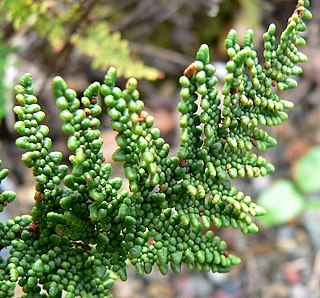
Myriopteris clevelandii, formerly known as Cheilanthes clevelandii, is a species of lip fern known by the common name Cleveland's lip fern. It is native to southern California and Baja California in Mexico. The leaf is divided into small, bead-like segments densely covered with scales beneath. In M. clevelandii, some of these scales are reduced to hairlike structures, which help distinguish it from the closely related M. covillei. It is usually found growing on exposed rock, particularly igneous rock.

Polypodium glycyrrhiza, commonly known as licorice fern, many-footed fern, and sweet root, is a summer deciduous fern native to western North America, where it is found in shaded, damp locations.
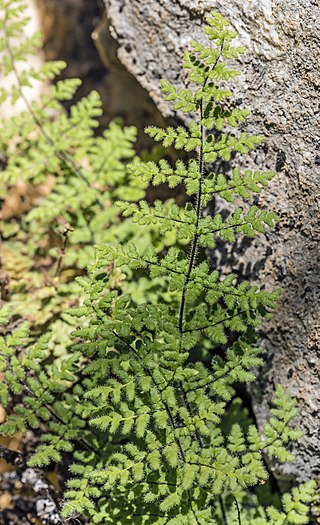
Myriopteris cooperae, formerly Cheilanthes cooperae, is a species of lip fern known by the common name Mrs. Cooper's lip fern, or simply Cooper's lip fern. Its leaves grow in clusters and are highly dissected into oblong segments, rather than the beadlike segments found in some other members of the genus. The axes of the leaves are dark and covered in long, flattened hairs. It is only known from California, where it grows in rocky habitats, usually over limestone. The species was named in honor of its collector, Sarah Paxson Cooper; according to Daniel Cady Eaton, who described it in 1875, it was the first fern species to be named for a female botanist.

Myriopteris gracillima, formerly known as Cheilanthes gracillima, is a species of lip fern known by the common name lace lip fern. It is native to western North America, where it grows in rocky habitat from British Columbia to California to Montana.

Myriopteris intertexta, formerly Cheilanthes intertexta, is a species of lip fern known by the common name coastal lip fern. It is native to montane California and western Nevada, Oregon east of the Cascades, and with a disjunct population in central Utah. It grows in dry rocky habitats in sun, typically in rock cracks with little or no soil.
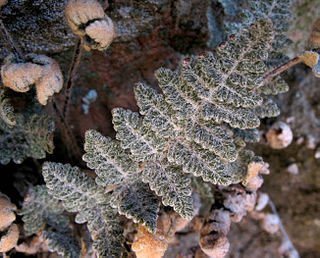
Myriopteris newberryi, formerly Cheilanthes newberryi, is a species of lip fern known by the common name Newberry's lip fern. It is native to southern California and Baja California.
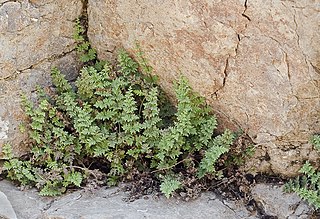
Myriopteris viscida, formerly known as Cheilanthes viscida, is a species of lip fern known by the common names viscid lip fern and viscid lace fern.

Polypodium virginianum, commonly known as rock polypody, rock cap fern, or common polypody, is a small evergreen species of fern native to the Eastern United States and Canada. It generally grows on rocks and occasionally on tree roots in nature.

Pellaea brachyptera is a species of fern known by the common name Sierra cliffbrake. It is native to the coastal and inland mountains of northern California and Oregon, and a disjunct population was discovered in Chelan County, Washington, in 1986.
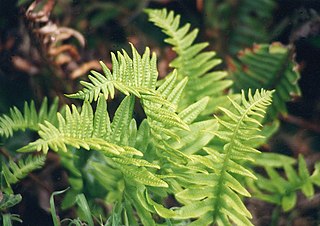
Polypodium californicum is a species of fern known by the common name California polypody.

Polypodium hesperium is a species of fern known by the common name western polypody. It is native to western North America from British Columbia to California, and the Rocky Mountains to northern Mexico, where it grows in rocky habitat types.

Polystichum californicum is a species of fern known by the common name California sword fern. It is native to western North America from British Columbia to California, where it occurs in the coastal mountain ranges and the Cascade Range through the Sierra Nevada. Its habitat includes forest understory and open rocky slopes. This fern produces several arching or erect leaves up to a meter long. Each lance-shaped leaf is made up of many sharp-toothed segments. The undersides bear rounded sori which contain the spores. This fern arose as a hybrid between other Polystichum species and readily forms hybrids of its own.
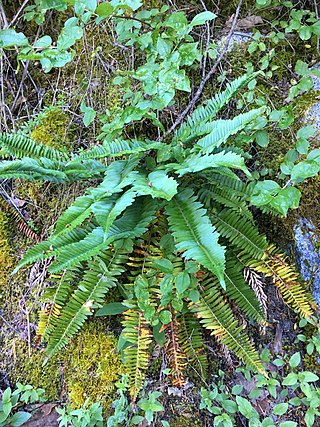
Polystichum imbricans is a species of fern known by the common names narrowleaf swordfern and imbricate sword fern. It is native to western North America from British Columbia and Idaho to southern California, where it grows in rocky soil and cracks in rock outcrops in coastal and inland mountain ranges and foothills.

Polypodium cambricum, the southern polypody, limestone polypody, or Welsh polypody, is a species of fern in the family Polypodiaceae, native to southern and western Europe where it grows on shady rocks, near the coasts of the Mediterranean Basin and in the mountains of Atlantic Europe. It is a spreading, terrestrial, deciduous fern growing to 60 centimetres (24 in) tall, with pinnate fronds. The sori are yellow in winter.

Polypodium is a genus of ferns in the family Polypodiaceae, subfamily Polypodioideae, according to the Pteridophyte Phylogeny Group classification of 2016 (PPG I). The genus is widely distributed throughout the world, with the highest species diversity in the tropics. The name is derived from Ancient Greek poly ("many") + podion, on account of the foot-like appearance of the rhizome and its branches. They are commonly called polypodies or rockcap ferns, but for many species unique vernacular names exist.
Argyrochosma delicatula is a fern known from northeastern Mexico. It grows in rocky habitats, either in sun or in shade, and is distinguished from similar species by the presence of pale yellow powder on the underside of its leaves. First described as a species in 1939, it was transferred to the new genus Argyrochosma in 1987, recognizing their distinctness from the "cloak ferns".

Polypodium amorphum is a species of fern with the common name irregular polypody, which grows near the northwest coast of North America.




















